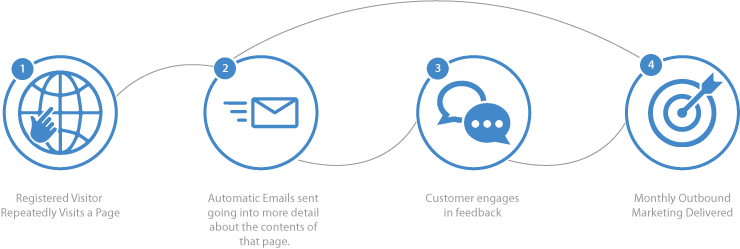JoomConnect Blog
Understanding Drip Campaigns and How to Use Them
Drip marketing can be a powerful tool to use as a campaign to communicate with your audience. Using these drip campaigns properly will help lead leads, prospects, and recurring clients to complete the actions that eventually bring about a completed transaction. Here, we’ll discuss how drip campaigns work, some common uses for them, and how to plan them out
What are Drip Campaigns, and How Do They Work?
Drip campaigns use triggers and user information to send out certain pieces of marketing materials, in a certain order, to the right audience. This material is designed to draw an audience in, guiding them through the marketing funnel and encouraging them to take the actions that will convert them from a prospect, to a lead, to a customer. Some drip campaigns are more specifically created to inspire another behavior or action in a targeted audience.
Boiled down, a drip campaign is intended to give certain groups of your audience the information, and thereby motivate them to continue forward in the buyer’s journey.
For example, you may have a registered user on your website that has repeatedly visited one of your service pages, but never moves further along towards a purchase. A drip campaign can allow you to send them more content specifically directed to their apparent interest. This could include emails that talk about the benefits of that service, accompanied by direct mail pieces that feature a special offer for that particular service. You might send a new user an email with suggested reads after they have received an email that thanks them for signing up on your website.
Using a drip email to reuse older content can even give it a 119 percent increase in click-through rates.
How Are Drip Campaigns Used?
There are many ways that a drip campaign can be leveraged to enhance or assist your marketing practices.
- Welcome Messages - as described above, a drip campaign can be used to create a personalized thank you/introductory message to someone who has newly become a contact. They can be used to direct them to a particular kind of content on your site, encouraging them to sign up for different mail streams and blog subscriptions. If sent as an email, these messages have an average open rate of 58.7 percent, and if sent immediately, this open rate can jump to 88.3 percent.
- Onboarding Messages - If you have a contact who has absorbed plenty of content, but still has yet to make a purchase, you might consider sending them a drip campaign dedicated to onboarding them. These messages will offer smaller ‘sells,’ only offering smaller transactions and relatively smaller purchases. These campaigns can help get these hesitant contacts more used to the idea of doing business with you, and give you the opportunity to prove yourself in your delivery.
- Encouraging Engagement (or Re-Engagement) - these drip campaigns can be used to remind a contact as to how they can interact with your website, and what benefits these interactions can bring. This tactic can help the marketing funnel produce higher conversion rates. As we touched upon in the example above, these are especially helpful if a contact repeats a particular activity--or repeatedly neglects a particular activity. Re-Engagement marketing activities might involve a quick reminder that the contact has not interacted with you for a while, or may encourage them to continue their business with you after a transaction has been made. These campaigns often include some form of incentive or perk to keep the contact in the transaction mode. These might take the form of confirmation messages that are sent in response to a user’s actions, like if they have sent in a ticket or a support request, or if they have made a purchase--this is the time to thank them for their business, and to try to upsell them with additional offers. On the flip side, a re-engagement campaign can also be used to keep a user from leaving you. A brief message expressing how sorry you are to see them go, accompanied by a special offer to see if they’re willing to change their minds can make all the difference. If it doesn’t, you can try to identify why they were dissatisfied and offer to remedy it for them. These messages should be sent as soon as the user clicks the ‘Submit’ button.
Planning Out a Drip Campaign
- Identifying Your Goals
First, you have to determine what it is that you are trying to encourage through your campaign. Are you nurturing leads? Boosting your engagement? Pushing for a purchase or encouraging reviews? Trying to keep someone engaged with some re-engagement activities? Something else? This determination will dictate how the rest of your campaign plays out. - Map Out the Campaign
Once you know what you’re trying to do, you have to establish how you’re going to do it. This involves establishing a timeline of when your marketing materials will be distributed, what form they will take, how long the time between messages will be, where you will send your respondents, and what offers or content you plan to entice your targets with. In order to do so, you need to account for each and every action your target could take in response to your marketing...including not responding at all. Once you’ve done so, determine which of your messages were more effective than others, and revise the ineffective ones to make them more effective. Taking the variability of your audience’s responses into account, you should ensure you have a action to take no matter what your audience does--whether they don’t respond, clickthrough but do nothing, or reach out in response (or any other option they can take). Once you’ve mapped these trails out, determine what action to take next, and where each drip finally ends.
- Build Your Drip Campaign
As you finally begin to put your drip campaign together, there are a few more considerations to take into account. Now that you’ve identified who the campaign is targeting, establish where that audience currently stands in the marketing funnel. What is your goal for that group? Make sure that all of your materials work toward that goal in some way. As you write your campaign, be thoughtful, but cautious. You want to make sure that your messages (especially the titles and subject lines) are intriguing or convincing enough to cause the recipient to read them, but you also don’t want to cross the line to becoming spammy. It helps if you are regularly updating your drip materials and personalizing them appropriately. It is important that any statistics you’ve cited, as well as any other time-sensitive information, is updated regularly to be as accurate as possible. There are marketing automation tools that can help you include personalized information in your drip content.
Finally, you have your well-planned drip campaign, ready for action. These campaigns will allow you to engage more with your clients, pushing them to the solution or service that fits them best. For more assistance with setting up drip campaigns to augment your marketing efforts, let’s talk.




Comments